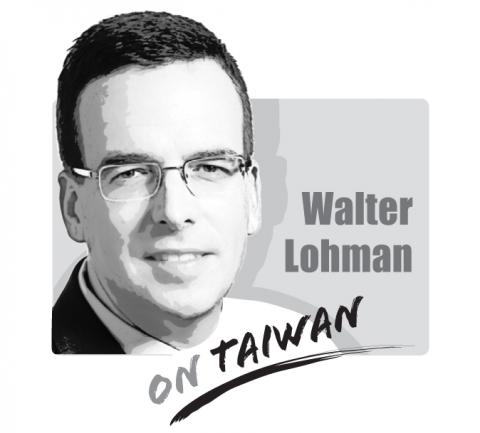Over the last couple of weeks, the US has entered into something resembling a trade war with China. It started with complaints about Chinese treatment of intellectual property (IP). But like the tariffs on steel and aluminum are not actually about national security, this quasi-war with China is not about IP.
So what is it about? To answer that you have to look at the views of those advocating it. They can be divided into two camps: economic nationalists and geopoliticians.
The economic nationalists see the US economy as a collective good. They speak in terms of “our” companies — whether or not they personally own stock in them. They talk about the sacrifice that some workers must take in order to benefit those who work in more “critical” industries. They are essentially central planners seeking, through government fiat, to reorder global value chains in ways that require greater industrial production in America.

Political party is not a reliable indicator of who might be an economic nationalist. Yes, they are well-represented in the upper reaches of the current administration, especially at the Office of the US Trade Representative (USTR) and the Commerce Department. Their weight is clear on a whole range of issues, from the above-mentioned steel and aluminum tariffs and pending auto tariffs to a dramatic increase in anti-dumping cases. But, in fact, the nationalists remain most comfortable on the Left, a position from which they have mounted opposition to virtually every American FTA.
The geopoliticians, by contrast, are mostly on the right. They share the collective mindset of the nationalists, and they define economic strength in a similar way. But their goal is different. For them, the strength of the American economy is not important as an end in and of itself; it is the sine qua non of great power competition with China. Their manifesto is the President’s National Security Strategy. That otherwise very sound document states very directly that “economic security is national security.”
This would all just be political science, though, if it were not for the real impact of their policy prescriptions. The problem is that their grand visions restrain the choices Americans can avail themselves of in structuring their businesses and ordering their households.
There is another way to approach China, one that can maximize the value Americans extract from the market, and at the same time, actually serve as a basis for addressing the real issue at hand, the security of IP in China.
It is an approach centered on economic freedom.
Its first rule is “economics is economics and politics are something else.” In the relationship with China, the US has to keep these separate. It cannot be naive. Beijing does have the aim of squeezing the US out of its leadership role in the Western Pacific. More concretely, the US and China have directly opposing interests in several of the region’s hotspots — Taiwan, North Korea, the East and South China Seas, and on the India-China border. Still, these differences need not interfere with the way the US conducts its economic relationship with China. It is challenging enough without a new layer of complexity.
No, the Chinese state-led capitalism does not lend itself to a similar firewall. But the US need not become more like China in order to secure its interests. There are costs to the mixed Chinese model, some of which, like environmental degradation and ballooning debt, are already apparent.
The second rule is “it is better to open markets than to close them.” If the US has a problem with market access in China, it should put them on the table, and use the leverage of its market to address them, not close its market with unilateral tariffs. Critics will say this has been tried and failed, and there is some truth to this. The Chinese repeat many of the same promises and never deliver. However, there has been incremental progress, in financial services, for example. Is it sufficient? No. But if the US is not seriously talking to them, it is difficult to shape outcomes.
The third rule is “when bilateral talks fail, go multilateral.” This means resort to the WTO. The US has more success at the WTO vis-a-vis China than current criticism of the body would lead one to believe. The CATO Institute has recently documented that on 21 out of 26 issues litigated against China since its entry into the WTO, “China’s response was to take some action to move towards greater access.” “There are no cases,” the report says, “where China has simply ignored rulings against it.” Still, where the WTO under-delivers — and it does — the US should work with trading partners like Japan, the EU, NAFTA partners and others to forge a common front to fix the WTO’s deficiencies. That is impossible when the US is skirmishing with them as well.
This brings us back to the matter that this quasi-war with China is ostensibly about, intellectual property protection. If this were really the issue, what would the free market alternative be to fixing it?
First, we have to acknowledge one uncomfortable fact. Not all the American companies who have given their technology to the Chinese are innocent victims. Joint ventures are more than Chinese schemes to bilk foreign companies. For some American companies sharing technology with their partners was part of their business plans. Granted, once a company is invested, it is unfair to hold that investment hostage to new demands. This is what makes China’s behavior egregious. But it is important to understand which companies were victimized and which went in knowing full well the price of entry.
Second, we have to put China’s abuses in some context. The US Chamber of Commerce’s International IP Index ranks China 25th out of 50 countries in terms of IP protection and enforcement. Granted, what China does on these issues is more consequential than some of the countries, like Russia and Thailand, that it outperforms. But its middling ranking is a good indication that the problem is not as dramatic as it is portrayed, and therefore subject to resolution.
Third, expand on the case the US has taken to the WTO. In addition to unilateral tariffs, the US has initiated a dispute settlement case at the WTO. In doing so, it made a point that unilateral action was necessary because some of its complaints fall outside the authority of the WTO. It is worth taking another look at this judgement. The EU has also filed a case, yet its case is broader, and it managed to pursue it without resort to unilateral sanctions.
Fourth, when it comes to cyber-espionage the US is well within its right to retaliate against the Chinese companies that perpetrate the theft and/or benefit from it. It should single out these entities and impose appropriate penalties on them.
Finally, the administration has to be clear and consistent that addressing Chinese IP abuses is its aim, not paring back Chinese industrial policy — which is unrealistic in any regard — or negotiating transactional arrangements designed to reduce the trade deficit — which is also unrealistic. If talks have any prospect of succeeding, they must narrow in on the matter at hand and set specific, detailed expectations.
A trade war with China may benefit a few select businesses in the United States. It will certainly damage many, their workers and the consumers that depend on the free flow of commerce. Even then, it will do nothing to fix the problem of China’s violation of intellectual property rights. To have the best prospects of doing that, while minimizing the impact of the effort, what’s needed is a different mindset — one that has at its heart less state-led design and more economic freedom.
Walter Lohman is director of the Heritage Foundation’s Asian Studies Center.
The US Senate’s passage of the 2026 National Defense Authorization Act (NDAA), which urges Taiwan’s inclusion in the Rim of the Pacific (RIMPAC) exercise and allocates US$1 billion in military aid, marks yet another milestone in Washington’s growing support for Taipei. On paper, it reflects the steadiness of US commitment, but beneath this show of solidarity lies contradiction. While the US Congress builds a stable, bipartisan architecture of deterrence, US President Donald Trump repeatedly undercuts it through erratic decisions and transactional diplomacy. This dissonance not only weakens the US’ credibility abroad — it also fractures public trust within Taiwan. For decades,
The government and local industries breathed a sigh of relief after Shin Kong Life Insurance Co last week said it would relinquish surface rights for two plots in Taipei’s Beitou District (北投) to Nvidia Corp. The US chip-design giant’s plan to expand its local presence will be crucial for Taiwan to safeguard its core role in the global artificial intelligence (AI) ecosystem and to advance the nation’s AI development. The land in dispute is owned by the Taipei City Government, which in 2021 sold the rights to develop and use the two plots of land, codenamed T17 and T18, to the

The ceasefire in the Middle East is a rare cause for celebration in that war-torn region. Hamas has released all of the living hostages it captured on Oct. 7, 2023, regular combat operations have ceased, and Israel has drawn closer to its Arab neighbors. Israel, with crucial support from the United States, has achieved all of this despite concerted efforts from the forces of darkness to prevent it. Hamas, of course, is a longtime client of Iran, which in turn is a client of China. Two years ago, when Hamas invaded Israel — killing 1,200, kidnapping 251, and brutalizing countless others
Taiwan’s first case of African swine fever (ASF) was confirmed on Tuesday evening at a hog farm in Taichung’s Wuci District (梧棲), trigging nationwide emergency measures and stripping Taiwan of its status as the only Asian country free of classical swine fever, ASF and foot-and-mouth disease, a certification it received on May 29. The government on Wednesday set up a Central Emergency Operations Center in Taichung and instituted an immediate five-day ban on transporting and slaughtering hogs, and on feeding pigs kitchen waste. The ban was later extended to 15 days, to account for the incubation period of the virus